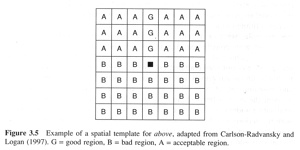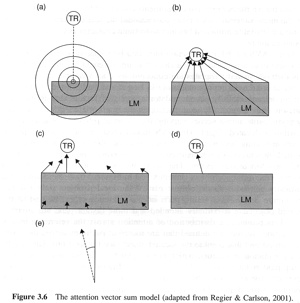Coventry, K. R., and Garrod, S. C. Saying, Seeing and Acting: the Psychological Semantics of Spatial Prepositions. Psychology Press, East Sussex, Great Britain, 2004, ch. Grounding language in perception: from “saying” to “saying and acting”, pp. 37–70.
———
This chapter opens with the argument that it is extremely difficult to pin down what expressions like “higher than” mean because natural language only encode a limited number of spatial relations between objects and these have to cover the whole range of possibilities. The authors propose a ‘functional geometric framework’ that enables to better comprehend spatial prepositions because it involves both geometric constraints and extra-geometric constraints.
The chapter first reviews the major contributions to the modelization of geometry of spatial relations. Cohn et al. (1996) developed a qualitative geometry of space called the region connection calcolus. Ullman (1996) argued that perceptual processing requires visual routines different from the basic process of basic vision. Visual routines serve functional perception. They are optimal and subject to attention control.
Logan and Sadler (1996) claim that spatial templates underlie the apprehension of spatial relations and spatial prepositions. A template is a representation that is centered on the reference object and aligned with the reference frame imposed on the reference object.
Regier and Carlson (2001) developed the attention vector sum model, a computational model to compute the relations captured by the spatial template theory. AVS takes into account the tole of attention in determining a spatial relation and has much the same character as one of Ullman’s visual routines. The model works by focusing an attentional beam on the reference object at the point that is vertically aligned with the closest part of the located object. Parts of the reference object nearest to the located object are masimally attended and more distant parts are attended less.
Finally the authors stress out the importance of including extra-geometric relation in order to ammeillorate the AVS framework. The spatial prepositions refer to the position of objects in space but also to tha content of a spatial preposition contributes to the meaning of an expression (the contained object moves toward the container).
The functional geometric framework aims to capture the representation of spatial relations not just in terms of how viewers see such relations, but also in terms of how they act on the world they see, and in terms of how objects meaningfully interact in that world. In synthesis the authors argues that what objects are fundamentally influences how one talks about where they are located.
[More]


